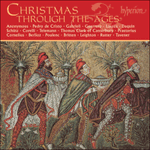
Welcome to Hyperion Records, a British classical label devoted to presenting high-quality recordings of music of all styles and from all periods from the twelfth century to the twenty-first.
Hyperion offers both CDs, and downloads in a number of formats. The site is also available in several languages.
Please use the dropdown buttons to set your preferred options, or use the checkbox to accept the defaults.

Many of the Noëls employ a cumulative variation technique in which the figuration becomes increasingly rapid as the piece progresses, producing an effect of ever greater brilliance. Stunning echo effects are achieved, as in Nos I, VI and X, by hopping from manual to manual (grand orgue, récit, écho). The pedal-writing in Nos II and IX implies a wide compass similar to the viola da gamba; this is accommodated by using the 4-foot flûte on its own.
from notes by David Ball © 1995
Beaucoup de Noëls comportent une technique de variation cumulative, dans laquelle la figuration devient de plus en plus rapide au fur et à mesure que le morceau avance, produisant un effet de brillance encore plus grand. De formidables effets d’échos sont réalisés dans les nos I, VI et X, en passant d’un clavier manuel à l’autre (grand orgue, récit, écho). La composition pour pédale dans les nos II et IX comporte une grande étendue semblable à la viole de gambe; cela fut rendu possible par l’utilisation de la flûte quatre-pieds seule.
extrait des notes rédigées par David Ball © 1995
Français: Catherine Loridan
Viele der Noëls verwenden eine kumulative Variationstechnik, in der die Figurierung im Laufe des Stückes zunehmend schneller wird und einen Effekt immer größerer Brillanz erzeugt. Überwältigende Echoeffekte, wie in den Nrn. I, VI und X, werden durch Springen von einem Manual zum anderen (grand orgue, récit, écho) erzielt. Die Pedalführung in den Nrn. II und IX deutet einen großen Umfang, ähnlich dem der Viola da gamba, an; darauf stellt man sich ein, indem man die 1,22m hohe flûte allein verwendet.
aus dem Begleittext von David Ball © 1995
Deutsch: Angela Ritter
 Christmas through the ages Christmas through the ages'Other than to assure you that it works for me, need I say more?' (Fanfare, USA) 'If Christmas music is on your agenda–for yourself or for your best friends or most favored family members, this disc['s] original sources should make ...» More |

